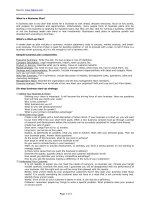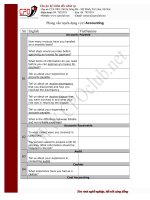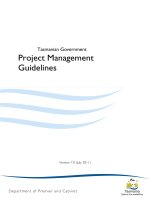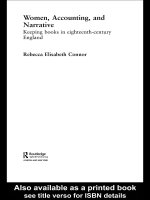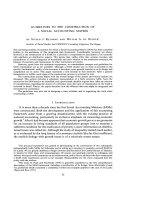Accounting guideline
Bạn đang xem bản rút gọn của tài liệu. Xem và tải ngay bản đầy đủ của tài liệu tại đây (1.02 MB, 41 trang )
Accounting Guideline
GRAP 103
Heritage
Assets
All rights reserved. No part of this publication may be reproduced, stored in retrieval system, or transmitted, in any form or by any means, electronic,
mechanical, photocopying, recording, or otherwise, without the prior permission of the National Treasury of South Africa.
Permission to reproduce limited extracts from the publication will not usually be withheld.
Though National Treasury (NT) believes reasonable efforts have been made to ensure the accuracy of the information contained in the guideline, it
may include inaccuracies or typographical errors and may be changed or updated without notice. NT may amend these guidelines at any time by
posting the amended terms on NT's Web site.
Note that this document is not part of the GRAP standard. The GRAP takes precedence while this guideline is used mainly to provide further
explanations on the concepts already in the GRAP.
GRAP 103 – Heritage Assets
Contents
1.
INTRODUCTION............................................................................................................ 3
2.
SCOPE .......................................................................................................................... 4
3.
THE BIG PICTURE ........................................................................................................ 5
4.
IDENTIFICATION........................................................................................................... 6
5.
INITIAL RECOGNITION ................................................................................................. 9
6.
7.
5.1.
General ................................................................................................................... 9
5.2.
Treatment of research and development costs ........................................................ 9
INITIAL MEASUREMENT ............................................................................................ 11
6.1.
General ................................................................................................................. 11
6.2.
Elements of cost .................................................................................................... 12
6.3.
Measurement of cost ............................................................................................. 12
SUBSEQUENT MEASUREMENT ................................................................................ 13
7.1.
General ................................................................................................................. 13
7.2.
Impairment ............................................................................................................ 14
7.3.
Revaluation model................................................................................................. 15
7.4.
Subsequent costs .................................................................................................. 22
7.5.
Compensation received from third parties ............................................................. 23
8.
TRANSFERS ............................................................................................................... 24
9.
DERECOGNITION ....................................................................................................... 31
10. DISCLOSURE .............................................................................................................. 34
11. ENTITY-SPECIFIC GUIDANCE ................................................................................... 37
11.1. Departments.......................................................................................................... 37
11.2. Municipalities ......................................................................................................... 37
12. SUMMARY OF KEY PRINCIPLES ............................................................................... 40
12.1. Identification .......................................................................................................... 40
12.2. Recognition ........................................................................................................... 40
12.3. Measurement ........................................................................................................ 40
12.4. Derecognition ........................................................................................................ 41
January 2014
Page 2
GRAP 103 – Heritage Assets
1.
INTRODUCTION
This document provides guidance on the accounting treatment and disclosure of heritage
assets.
The contents should be read in conjunction with GRAP 103 (issued July 2008).
For purposes of this guide, “entities” refer to the following bodies to which the standards of
GRAP relate to, unless specifically stated otherwise:
•
National and provincial departments
•
Public entities
•
Constitutional institutions
•
Municipalities and all other entities under their control
•
Parliament and the provincial legislatures
Explanation of images used in manual:
Definition
Take note
Management process and decision making
Example
January 2014
Page 3
GRAP 103 – Heritage Assets
2.
SCOPE
GRAP 103 is applicable to all entities preparing their financial statements on the accrual
basis of accounting.
If an entity manages the biological transformation of an asset, and that asset also
meets the definition of a heritage asset as defined in GRAP 103, that asset should be
recognised, measured and disclosed in terms of GRAP 27 - Agriculture. Refer to
accounting guideline GRAP 27 for detail.
Accounting for heritage assets
Currently, entities have an option with regards to the accounting for heritage assets,
i.e. they can apply the principles in GRAP 17 – Property, Plant and Equipment, or
apply the principles in GRAP 103.
Under GRAP 17, it is not compulsory to recognise heritage assets which would
otherwise meet the recognition criteria of that standard. Refer to the accounting
guideline GRAP 17 for detail. If an entity does however recognise heritage assets, it
is not necessary to apply the measurement principles of GRAP 17, but the disclosure
requirements of GRAP 17 must be applied.
If an entity applies the principles in GRAP 103 to account for heritage assets, an entity
should comply in full with the recognition, measurement and disclosure requirements
in the standard. Refer to the sections on recognition, initial measurement,
subsequent measurement and disclosure for detail.
For entities that are applying GRAP 17, it should be noted that once GRAP 103 is
elected, the option to account for heritage assets in terms of GRAP 17 will be
removed.
January 2014
Page 4
3.
THE BIG PICTURE
Figure 1
January 2014
Page 5
4.
IDENTIFICATION
Heritage assets are assets that have cultural, environmental, historical, natural,
scientific, technological or artistic significance and are held indefinitely for the benefit
of present and future generations.
F.A.Q
One of the most frequently asked questions are: How does an entity distinguish
heritage assets from “old assets”?
Answer: Entities frequently use own items of property, plant and equipment, intangible
assets, inventories and other types of assets that are old but are still being used
functionally. For example, an entity may own old furniture such as desks and chairs
that are being used for administrative purposes and meet the definition of property,
plant and equipment.
“Old assets” are not the same as “heritage assets” as heritage assets should meet the
definition criteria (see above).
One of the key features of heritage assets is that they are held indefinitely for the
purposes of preserving such assets for the benefit of present and future generations.
This means that entities often incur expenditure to preserve and extend the life of an
asset so that it can be enjoyed by future generations. As a result of the preservation of
heritage assets, their value often increases over time, making the effect of
depreciation negligible.
The purpose of holding items of Property, Plant and Equipment and other assets is for
them to be used in executing an entity‟s activities. As a result, these assets are
“consumed” over time or as they are used.
Entities should therefore ascertain what the purpose is of holding various assets in
determining whether they should be treated as “heritage assets” or as other assets in
accordance with the relevant Standards of GRAP.
Some characteristics often displayed by heritage assets that an entity can consider (note:
that not all heritage assets necessarily display these characteristics):
Their value in cultural, environmental, educational and historical terms is unlikely to be
fully reflected in monetary terms;
The value of these assets tend to increase over time even if their physical condition
deteriorates;
They are often irreplaceable;
They have indefinite useful lives and their value appreciates over time due to their
cultural, environmental, historical, natural, scientific, technological or artistic significance
(refer to example below);
Ethical, legal and/or statutory obligations may impose prohibitions or severe stipulations
on disposal by sale;
January 2014
Page 6
They are protected, kept unencumbered, cared for and preserved.
Example 1: Identification heritage assets
Examples of assets that could be regarded as classes of heritage assets:
Sites declared national heritage sites by government;
Collections of insects, butterflies and fossils;
Historical monuments, including graves and burial grounds;
Archaeological and paleontological sites;
Conservation areas such as national parks;
Objects of scientific or technological interest such as rare species;
Historical buildings that have significant historical associations e.g., churches,
museums, courthouses, prisons, hospitals;
Moveable objects such as medals, coins, stamps or objects of decorative or fine
art;
Works of art, antiquities and exhibits, such as biological and mineral specimens or
technological artefacts;
Collections of rare books, manuscripts, records, photos and other materials held
by libraries to be preserved for their historical and cultural value;
Intangible heritage assets such as recordings of significant historical events and
rights to use the likeness of a significant public person on, for example, postage
stamps or collectible coins;
A notable figure, organisation, event or period with a historical significance;
Industrial, scientific, and technical innovations; and
A particular building type, style, period or architect of architectural significance.
In summary, some key features of heritage assets that can be used in indentifying an
asset as a heritage asset:
The asset is held indefinitely;
The government has declared the asset as of historical significance;
The asset is protected, cared for and preserved for present and future generations;
The asset‟s value increases over time;
No monetary value can sometimes be placed on the asset; and
Other relevant factors.
If an entity still cannot determine whether the asset is a heritage asset or property, plant
and equipment, intangible asset or biological asset, it should ascertain the purpose of
holding the asset, i.e. is it used to execute the entity‟s activities or for another purpose.
If it is used to execute an entity‟s activities, it is most likely an asset other than a
heritage asset.
January 2014
Page 7
There are instances where heritage assets can have a dual purpose, for example where an
historical building meets the definition of a heritage asset, but it is also used for offices.
These assets that are used for more than one purpose can only be classified as a heritage
asset when a significant portion of the asset meets the definition of a heritage asset. The
entity cannot split an asset into two or more classifications. For example: a portion of a
property cannot be classified as property, plant and equipment and another portion classified
as heritage assets. The full asset is either a heritage asset or it is not a heritage asset.
Determining whether or not the heritage portion is significant or not is a judgement that
should be made by management. This judgement should be applied consistently
between all the assets.
To ensure consistent application of the criteria, it is recommended that management
include the judgement criteria as part of their asset management policy.
January 2014
Page 8
5.
INITIAL RECOGNITION
5.1. General
Heritage assets should be recognised only when:
It is probable that future economic benefits or service potential associated with the asset
will flow to the entity; and
The cost or fair value of the asset can be measured reliably.
5.2. Treatment of research and development costs
Refer to accounting guideline GRAP 31 for guidance on the treatment of research and
development costs, i.e. exploration costs, incurred in searching for new heritage assets. As
the entity will not be able to demonstrate at the research phase that a heritage asset that
meets the recognition and measurement criteria will be located, the entity should recognise
the expenditure as expenses when it is incurred, in terms of GRAP 31 – Intangible assets.
Only costs incurred that meet the criteria for recognition as development costs, as indicated
in GRAP 31, can be capitalised in the carrying amount of the heritage asset.
Example 2: Research and development costs – restoration costs incurred
Entity R&D received information of the existence of voice recordings of private
conversations between Jan Smuts and Winston Churchill during the Second World
War that may be of historical significance and subsequently underwent exploration
costs to search for the recordings. At the reporting date, 31 March 2009, nothing was
found as yet.
The exploration cost for the period amounted to R500,000.
On 1 April 2009 , entity R&D discovered the voice recordings and preliminarily verified
the authenticity. No costs were further costs were incurred.
However, the recordings were badly damaged and had to be restored and digitally remastered, after which an extensive verification process was followed to guarantee the
authenticity. The costs of the verification, restoration and re-mastering amounted to
R300,000.
Journal entries:
The journal entries for the two periods would be as follows:
31 March 2009
Research cost
Bank/Creditor
Debit
Credit
R
R
500,000
500,000
Recognising restoration costs incurred
January 2014
Page 9
31 March 2010
Heritage assets
Bank/Creditor
Debit
Credit
R
R
300,000
300,000
Recognising development costs incurred
As mentioned earlier under the section on Identification, an example of a heritage asset is
an object of scientific or technological interest. If an entity incurs cost, for example research
and development costs, to develop an object for scientific or technological purposes, the
costs should be accounted for in accordance with GRAP 31 – Intangible assets, i.e. research
costs should be expensed and development costs should be capitalised (only if it meets the
specific recognition criteria).
During the research and/or development phase, an entity might not yet know whether the
asset will be a heritage asset, and therefore, when capitalising the development costs, the
asset recognised will be an intangible asset at that stage. However, when an entity
subsequently determines (even after a few years) that the asset has become a heritage
asset and that it meets the definition and recognition criteria of a heritage asset, it can then
transfer the carrying amount of the intangible asset to heritage assets and account for the
asset under GRAP 103 from that point forward.
For more detail on transfers to and from heritage assets, refer to the section on Transfers.
January 2014
Page 10
6.
INITIAL MEASUREMENT
6.1. General
Heritage assets which qualify for recognition as an asset should initially be measured at
cost.
Where heritage assets were acquired for no cost or nominal cost its cost should be
measured at fair value on the date of acquisition.
Heritage assets may be gifted or contributed to an entity and therefore obtained at no cost.
GRAP 23 - Revenue from Non-exchange Transactions deals with the recognition and
measurement of assets under these situations, as well as with the accounting for grants
received for the acquisition of assets.
For example, a museum may receive a valuable art collection from the estate of a
benefactor. The cost will then be the fair value of the art collection at transaction date.
In determining the fair value of a heritage asset acquired through a non-exchange
transaction, an entity should apply the principles under the section on determining the fair
value.
Subsequent to the recognition of such an asset, an entity can choose to adopt either the
revaluation model or the cost model in accordance with GRAP 103.
Measuring heritage assets at initial recognition at fair value vs. measuring
heritage assets using the revaluation value model for subsequent
measurement
Remember that the initial measurement at fair value of an asset acquired at no cost
does not call for the use of nor does it imply the use of the revaluation model for
subsequent measurement.
If a heritage asset is measured at fair value on initial recognition, the value will
deemed to be the cost under subsequent measurement, if the cost model is used.
However, if the revaluation model is used under subsequent measurement, the
revalued amount is usually either the market value determined by appraisal or the fair
value by reference to other items with similar characteristics, etc. The movements in
the revalued amount will be recognised in a revaluation surplus in net assets.
For more detail on the revaluation model (and cost model), refer to the section on
Subsequent measurement.
January 2014
Page 11
If an entity cannot recognise a heritage asset (or class of heritage assets), which would
otherwise meet the definition and recognition criteria of a heritage asset, because at
initial recognition it cannot reliably measure its cost or fair value, the entity should
disclose relevant and useful information about the heritage asset in the notes to the
financial statements.
Thus, where heritage assets cannot be reliably measured at initial recognition
GRAP 103 requires disclosure only.
Note that this refers to the initial recognition of a heritage asset, and should be
distinguished from instances where a heritage asset‟s fair value cannot be reliably
determined subsequent to initial recognition. In that case, the cost or fair value could
be determined for recognition purposes, but at subsequent measurement, under the
revaluation model, the fair value could not be reliably determined. Refer to the section
on Subsequent measurement for more detail.
6.2. Elements of cost
Cost can include:
purchase price after deducting trade discounts and rebates;
import duties;
non-refundable purchase taxes;
any direct cost to bring the asset to the location and condition necessary for it to be
capable of operating in the manner intended by management. These cost may include:
o cost incurred to initially move or remove the asset to its site;
o professional fees;
o initial delivery and handling fees; and
o installation cost.
Capitalisation of costs should cease as soon as the asset is in the location and condition
necessary for it to be capable of operating in the manner intended by management.
6.3. Measurement of cost
The cost is the cash price or the cash price equivalent at recognition date. If payment is
deferred beyond normal credit terms, then the cost of the heritage asset is the cash price
equivalent. The difference between this amount and the total payments is recognised as
interest expense over the period of credit given, unless it is capitalised in accordance with
GRAP 5 – Borrowing Costs. Refer to the accounting guideline GRAP 5 for more detail.
January 2014
Page 12
7.
SUBSEQUENT MEASUREMENT
7.1. General
An entity should choose either the cost model or the revaluation model for subsequent
measurement of an entire class of heritage assets.
Class of heritage assets means a grouping of heritage assets of a similar nature or
function in an entity‟s operations that is shown as a single item for the purpose of
disclosure in the financial statements. Examples include:
Art collections;
Stamp collections;
Collections of rare books and manuscripts;
Historical buildings; or
Historical structures.
Note that these are only examples, and it is an entity‟s choice which classes will be
disclosed.
Cost model
When the cost model is used, heritage assets are subsequently carried at cost less any
accumulated impairment losses. Entities are, however, still encouraged to disclose the fair
value of heritage assets for which the cost model is used.
Due to the nature of heritage assets, i.e. they are held for an indefinite period, heritage
assets are not depreciated, as they do not have a limited useful life. Any diminution in
value may also be immaterial.
January 2014
Page 13
Revaluation model
For subsequent measurement, if the fair value of a class of heritage assets can be
measured reliably, then the entity should carry that class of heritage assets at a revalued
amount. The revalued amount is the fair value at the date of the revaluation.
7.2. Impairment
As indicated earlier, heritage assets are not depreciated. However, at each reporting date,
the entity needs to assess (in accordance with GRAP 26 - Impairment of Cash-generating
Assets and GRAP 21 - Impairment of Non-cash-generating Assets) whether or not there is
an indication that the heritage assets might be impaired. If there is an indication of
impairment, then the recoverable amount or recoverable service amount should be
determined in respectively.
An impairment loss is the amount by which the carrying amount of the asset exceeds
its recoverable amount or recoverable service amount.
When assets are carried at cost under the cost model, any impairment loss or reversal of
impairment loss is recognised in surplus or deficit
When assets are carried at revalued amounts, an impairment loss is treated as a revaluation
decrease – i.e. is recognised in the revaluation reserve to the extent of a revaluation surplus
available. The reversal of an impairment loss previously recognised, should be treated as a
revaluation increase – i.e. is recognised in the revaluation reserve (unless it is first
recognised in surplus or deficit to reverse a previous impairment loss recognised in surplus
or deficit, in which case, only any excess will be recognised in the revaluation reserve).
Refer to accounting guideline GRAP 21 for guidance on the impairment of non-cashgenerating assets and refer to accounting guideline GRAP 26 for guidance on the
impairment of cash-generating assets. These guidelines will provide indicators of impairment
that an entity should consider, guidance on how to determine the recoverable amount and
recoverable service amount of impaired assets and how to recognise impairment losses and
reversals of impairment losses.
January 2014
Page 14
7.3. Revaluation model
Important to note when applying the revaluation model:
Revaluations should be made with sufficient regularity to ensure that the carrying
amount of the heritage asset does not differ materially from that which would be
determined using fair value at the reporting date.
The frequency of revaluation depends on the changes in the fair value of the heritage
assets being revalued. For a heritage asset that shows insignificant changes in fair
value, it may be necessary to revalue the heritage asset only every three to five years.
Heritage assets that experience significant and volatile changes in fair value require
annual revaluation. This is an accounting policy choice that has to be made and applied.
When one heritage asset in a class is revalued then the whole class should be revalued
(except where the fair value of a specific heritage asset in that same class cannot be
determined reliably).
Determining the fair value
In determining the fair value, the entity should consider the following:
The fair value should be determined without any deductions for transaction costs it may
incur on sale or disposal;
The parties to the transactions should be “knowledgeable” and “willing”.
o Knowledgeable implies that both the willing buyer and willing seller are reasonably
informed about the asset, thus they are informed about the nature and
characteristics, its actual and potential uses and market conditions at reporting date;
o Willing implies that the buyer is not overeager nor determined to buy at any price and
the seller is not over-eager nor forced to sell;
The transaction should take place at arm‟s length, therefore the transaction should be
between parties that do not have a particular or special relationship. Hence the
transaction is presumed to be between unrelated parties;
When heritage assets are used for more than one purpose, then the fair value should
reflect both the heritage value and the value obtained from its use in the production or
supply of goods or services; and
When the fair value of a collection is determined, then the entity should consider
reassessing the collection‟s fair value if the fair value of the individual items is less than
the collection‟s fair value.
January 2014
Page 15
Figure 2 – the 3 methods for determining the fair value of heritage assets
The fair value can be determined by applying one of three methods:
The best evidence of fair value is given by quoted prices in an active and liquid market,
especially published price quotations, such as quoted prices from recent auctions
published in local newspapers;
Should there not be an active and liquid market then a valuation technique may be used.
These techniques include:
o Recent arm‟s length transactions between knowledgeable, willing parties;
o Reference to the current fair value of other heritage assets with substantially similar
characteristics in similar circumstances and location adjusted for specific differences;
and
In the case of specialised heritage assets or man-made heritage structures (such as
statutes or monuments), an entity may need to determine the fair value using a
replacement cost approach. The reproduction cost or the restoration cost approach may
be the best indicator of the heritage asset‟s replacement cost.
The replacement cost is the cost to replace the service potential of an asset.
The reproduction cost is the cost of creating an exact replica of the asset.
The restoration cost is the cost that would be incurred in order to bring the asset's
service potential back to its pre-impaired level.
January 2014
Page 16
Note that a restriction on the disposal of a heritage asset from a stipulation imposed by the
seller or transferor does not prevent or make it impossible for an entity to determine the fair
value.
Accounting treatment of increases and decreases in the carrying amount as a result
of a revaluation
Revaluation increase or decrease
Under the revaluation model, the difference between the revalued amount and the carrying
amount is recognised in the revaluation surplus. In the case of a reversal of an increase
previously recognised in revaluation surplus, or a reversal of a decrease previously
recognised in surplus or deficit, it will be recognised in surplus or deficit.
An amount recognised in surplus or deficit is shown as an impairment loss.
To summarise:
Annual
financial
statements
First revaluation
Subsequent revaluation
results in an increase in
carrying amount
Subsequent
revaluation results in
a decrease in the
carrying amount
In the
statement of
changes in
net assets
Increase in carrying
amount of asset is
credited against
revaluation surplus
Secondly, where no
impairment loss available,
the increase (or any
excess in the case where
impairment loss was
previously recognised in
surplus or deficit) is
recognised in revaluation
surplus
Firstly, reverse
revaluation surplus
previously recognised,
if any
In the
statement of
financial
performance
Decrease in
carrying amount of
asset is recognised
as impairment loss
in surplus or deficit
Firstly, reverse the
impairment loss previously
recognised in surplus or
deficit, if any
Secondly, where no
revaluation surplus
available, the decrease
(or any excess in the
case where revaluation
surplus was available)
is recognised in surplus
or deficit
The accounting treatment of revaluation increases and decreases are illustrated in the
examples below.
Example 3: Subsequent increase in carrying amount as a result of a revaluation
Entity HTI subsequently measures all heritage assets using the revaluation model. The
reporting date of the entity is 30 June. Entity HTI only has two buildings which are
classified as heritage assets and their details are as follows:
January 2014
Page 17
Information
Building A
Building B
Acquisition date
1 July 2008
1 July 2008
Acquisition price
2,500,000
1,800,000
Fair value 30 June 2009
2,300,000
2,200,000
Fair value 30 June 2010
2,600,000
2,250,000
The journal entries for Building A would be as follows:
1 July 2008
Heritage assets
Debit
Credit
R
R
2,500,000
Bank
2,500,000
30 June 2009
Impairment loss (surplus or deficit)
Debit
Credit
R
R
200,000
Heritage assets (R2,500,000 – R2,300,000)
200,000
30 June 2010
Heritage assets (R2,600,000 – R2,300,000)
Debit
Credit
R
R
300,000
Reversal of impairment loss
200,000
Revaluation surplus/reserve (net assets)
100,000
The revaluation increase of R300,000 from the prior period to the current period was
first allocated against the R200,000 recognised in surplus or deficit in the prior period
and the difference was then allocated to the revaluation surplus.
The journal entries for Building B would be as follows:
1 July 2008
Heritage assets
Debit
Credit
R
R
1,800,000
Bank
30 June 2009
January 2014
1,800,000
Debit
Credit
R
R
Page 18
Heritage assets (R2,200,000 – R1,800,000)
400,000
Revaluation surplus/reserve (net assets)
400,000
30 June 2010
Heritage assets (R2,250,000 – R2,200,000)
Debit
Credit
R
R
50,000
Revaluation surplus/reserve (net assets)
50,000
No decrease was previously recognised in surplus or deficit, therefore the increase will
be credited in the revaluation surplus.
Example 4: Subsequent decrease in carrying amount as a result of a revaluation
Entity HTI subsequently measures all heritage assets using the revaluation model. The
reporting date of the entity is 30 June. Entity HTI has only two buildings classified as
heritage assets and their details are as follows:
Information
Building A
Building B
Acquisition date
1 July 2008
1 July 2008
Acquisition price
2,500,000
1,800,000
Fair value 30 June 2009
2,700,000
1,700,000
Fair value 30 June 2010
2,200,000
1,650,000
The journal entries for Building A would be as follows:
1 July 2008
Heritage assets
Debit
Credit
R
R
2,500,000
Bank
30 June 2009
Heritage assets (R2,700,000 – R2,500,000)
2,500,000
Debit
Credit
R
R
200,000
Revaluation surplus (net assets)
30 June 2010
January 2014
200,000
Debit
Credit
R
R
Page 19
Revaluation surplus (net assets)
200,000
Impairment loss (surplus or deficit)
300,000
Heritage assets (R2,700,000 – R2,200,000)
500,000
The revaluation decrease of R500,000 from the prior period to the current period was
first allocated against the balance available in the revaluation surplus, i.e. R200,000
and the difference was then allocated to surplus or deficit.
The journal entries for Building B would be as follows:
1 July 2008
Heritage assets
Debit
Credit
R
R
1,800,000
Bank
30 June 2009
Impairment loss (surplus or deficit)
1,800,000
Debit
Credit
R
R
100,000
Heritage assets (R1,800,000 – R1,700,000)
30 June 2010
Impairment loss (surplus or deficit)
Heritage assets (R1,700,000 – R1,650,000)
100,000
Debit
Credit
R
R
50,000
50,000
No increase was previously recognised in the revaluation reserve, therefore the
decrease will be recognised in surplus or deficit.
Inability to determine the fair value reliably
When the entity selected and applied the revaluation model and the entity is subsequently
unable to reliably determine the fair value, then the specific asset for which no fair value can
be determined, should be measured using the cost model. This only applies in exceptional
circumstances where no market-determined prices or values are available and alternative
estimates of the fair value are clearly unreliable.
Only the asset that cannot be fair valued should be measured according to the cost
model, while the entity should continue to measure all other heritage assets in the class
using the revaluation model.
If the fair value of the heritage asset can be determined by reference to an active market at a
subsequent date, the revaluation model should again be applied from that date.
January 2014
Page 20



